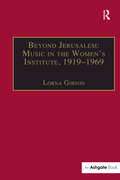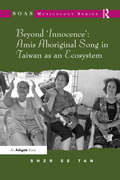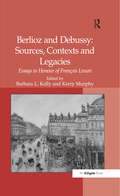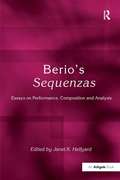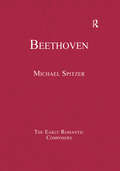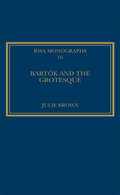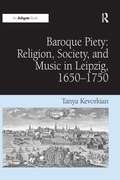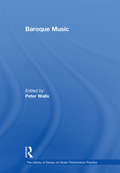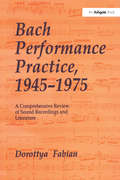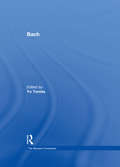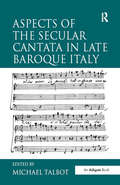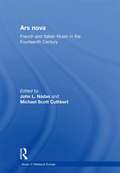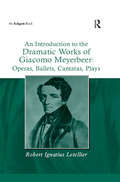- Table View
- List View
Beyond Jerusalem: Music in the Women's Institute, 1919-1969
by Lorna GibsonMusic in the Women's Institute has become stereotyped by the ritualistic singing of Jerusalem at monthly meetings. Indeed, Jerusalem has had an important role within the organization, and provides a valuable means within which to assess the organization's relationship with women's suffrage and the importance of rurality in the Women's Institute's identity. However, this book looks beyond Jerusalem by examining the full range of music making within the organization and locates its significance within a wider historical-cultural context. The Institute's promotion of conducting - a regular part of its musical activity since the 1930s - is discussed within the context of embodying overtly feminist sentiments. Lorna Gibson concludes that a redefinition of the term 'feminism' is needed and the concept of 'gendered spheres' of conducting provides a useful means of understanding the Institute's policy. The organization's promotion of folk song is also examined and reveals the Institute's contribution to the Folk Revival, as well as providing a valuable context within which to understand the National Federation's first music commission, Ralph Vaughan Williams's Folk Songs of the Four Seasons (1950). This work, and the Institute's second commission, Malcolm Williamson's The Brilliant and the Dark (1969), are examined with the context of the organization's music policy. In addition to discussing the background to the works, issues of critical reception are addressed. The book concludes with an Epilogue about the National Society Choir (later known as the Avalon Singers), which tested the organization's commitment to amateur music making. The book is the result of meticulous work undertaken in the archives of the National Federation, the BBC Written Archives Centre, the V&A archives, the Britten-Pears Library, the Ralph Vaughan Williams Library, the Women's Library and the Newspaper Library.
Beyond Jerusalem: Music in the Women's Institute, 1919-1969
by Lorna GibsonMusic in the Women's Institute has become stereotyped by the ritualistic singing of Jerusalem at monthly meetings. Indeed, Jerusalem has had an important role within the organization, and provides a valuable means within which to assess the organization's relationship with women's suffrage and the importance of rurality in the Women's Institute's identity. However, this book looks beyond Jerusalem by examining the full range of music making within the organization and locates its significance within a wider historical-cultural context. The Institute's promotion of conducting - a regular part of its musical activity since the 1930s - is discussed within the context of embodying overtly feminist sentiments. Lorna Gibson concludes that a redefinition of the term 'feminism' is needed and the concept of 'gendered spheres' of conducting provides a useful means of understanding the Institute's policy. The organization's promotion of folk song is also examined and reveals the Institute's contribution to the Folk Revival, as well as providing a valuable context within which to understand the National Federation's first music commission, Ralph Vaughan Williams's Folk Songs of the Four Seasons (1950). This work, and the Institute's second commission, Malcolm Williamson's The Brilliant and the Dark (1969), are examined with the context of the organization's music policy. In addition to discussing the background to the works, issues of critical reception are addressed. The book concludes with an Epilogue about the National Society Choir (later known as the Avalon Singers), which tested the organization's commitment to amateur music making. The book is the result of meticulous work undertaken in the archives of the National Federation, the BBC Written Archives Centre, the V&A archives, the Britten-Pears Library, the Ralph Vaughan Williams Library, the Women's Library and the Newspaper Library.
Beyond 'Innocence': Amis Aboriginal Song in Taiwan as an Ecosystem
by ShzrEe TanTaiwan aboriginal song has received extensive media coverage since the launch and settlement of a copyright lawsuit following pop group Enigma's allegedly unauthorized use of Amis voices in the 1996 Olympics hit, Return To Innocence. Taking as her starting point the ripple effects of this case, Shzr Ee Tan explores the relationship of this song culture to contemporary Amis society. She presents Amis song in its multiple manifestations as an ecosystem, symbiotic components of which interact and feed back upon one another in cross-cutting platforms of village life, festival celebration, cultural performance, popular song, art music and Christian hymnody. Tan's investigation hinges upon drawing a conceptual line between ladhiw, the Amis term for 'song' - a word vested with connotations of life-force, tradition, ritual and taboo - and the foreign term of yinyue ('music' - borrowed from Mandarin). This difference forms the basis of how Amis song is (re)constructed through processes of modernization, Christianization and politico-economic change. A single Amis melody, for example, can exist in several guises that are contextually exclusive but functionally mutually-supportive. Thus, a weeding song (ladhiw), which may have lost its traditional context of existence following advancements in farming technology, becomes sustained within a larger ecosystem, finding new life on the interacting platforms of Amis Catholic hymnody, karaoke and tourist shows. The latter genres (collectively, yinyue) may not rely on traditional livelihoods for survival, but thrive on a traditional melody's deeper associations to local memory and idealized Amis identities. While these new and old genres are stylistically separate, they feed into each other and back into themselves - through transforming contexts and cross-referenced memes - in organic and developing cycles of song activity. Drawing from fieldwork conducted from 2000-2010 as well as a background in ethnomusicology and journalism, Ta
Beyond 'Innocence': Amis Aboriginal Song in Taiwan as an Ecosystem
by ShzrEe TanTaiwan aboriginal song has received extensive media coverage since the launch and settlement of a copyright lawsuit following pop group Enigma's allegedly unauthorized use of Amis voices in the 1996 Olympics hit, Return To Innocence. Taking as her starting point the ripple effects of this case, Shzr Ee Tan explores the relationship of this song culture to contemporary Amis society. She presents Amis song in its multiple manifestations as an ecosystem, symbiotic components of which interact and feed back upon one another in cross-cutting platforms of village life, festival celebration, cultural performance, popular song, art music and Christian hymnody. Tan's investigation hinges upon drawing a conceptual line between ladhiw, the Amis term for 'song' - a word vested with connotations of life-force, tradition, ritual and taboo - and the foreign term of yinyue ('music' - borrowed from Mandarin). This difference forms the basis of how Amis song is (re)constructed through processes of modernization, Christianization and politico-economic change. A single Amis melody, for example, can exist in several guises that are contextually exclusive but functionally mutually-supportive. Thus, a weeding song (ladhiw), which may have lost its traditional context of existence following advancements in farming technology, becomes sustained within a larger ecosystem, finding new life on the interacting platforms of Amis Catholic hymnody, karaoke and tourist shows. The latter genres (collectively, yinyue) may not rely on traditional livelihoods for survival, but thrive on a traditional melody's deeper associations to local memory and idealized Amis identities. While these new and old genres are stylistically separate, they feed into each other and back into themselves - through transforming contexts and cross-referenced memes - in organic and developing cycles of song activity. Drawing from fieldwork conducted from 2000-2010 as well as a background in ethnomusicology and journalism, Ta
Berlioz and Debussy: Essays in Honour of Fran-s Lesure
by Kerry MurphyThis collection of essays by scholars of nineteenth- and early twentieth-century French music has been assembled in homage to the influential and inspirational French musicologist Fran‘s Lesure who died in 2001. Lesure's immense erudition was legendary and spanned music from the sixteenth to the twentieth century. Two French composers who were particular foci in his scholarship were Berlioz and Debussy and this collection is based on scholarship around these two composers and the sources, contexts and legacies relating to their work.
Berlioz and Debussy: Essays in Honour of Fran-s Lesure
by Kerry MurphyThis collection of essays by scholars of nineteenth- and early twentieth-century French music has been assembled in homage to the influential and inspirational French musicologist Fran‘s Lesure who died in 2001. Lesure's immense erudition was legendary and spanned music from the sixteenth to the twentieth century. Two French composers who were particular foci in his scholarship were Berlioz and Debussy and this collection is based on scholarship around these two composers and the sources, contexts and legacies relating to their work.
Berio's Sequenzas: Essays on Performance, Composition and Analysis
by Maureen Ep Janet K. HalfyardBetween 1958 and 2002, Luciano Berio wrote fourteen pieces entitled Sequenza, along with several versions of the same work for different instruments, revisions of the original pieces and also the parallel Chemins series, where one of the Sequenzas is used as the basis for a new composition on a larger scale. The Sequenza series is one of the most remarkable achievements of the late twentieth century - a collection of virtuoso pieces that explores the capabilities of a solo instrument and its player, making extreme technical demands of the performer whilst developing the musical vocabulary of the instrument in compositions so assured and so distinctive that each piece both initiates and potentially exhausts the repertoire of a new genre. The Sequenzas have significantly influenced the development of composition for solo instruments and voice, and there is no comparable series of works in the output of any other composer. Series of pieces tend to be linked by the instruments for which the composer writes, but this is a series in which the pieces are linked instead by the variety of instruments for which Berio composed. The varied approaches taken by the contributors in discussing the pieces demonstrate the richness of this repertoire and the many levels on which Berio and these landmark compositions can be considered. Contributions are arranged under three main headings: Performance Issues; Berio's Compositional Process and Aesthetics; and Analytical Approaches.
Berio's Sequenzas: Essays on Performance, Composition and Analysis
by JanetK. HalfyardBetween 1958 and 2002, Luciano Berio wrote fourteen pieces entitled Sequenza, along with several versions of the same work for different instruments, revisions of the original pieces and also the parallel Chemins series, where one of the Sequenzas is used as the basis for a new composition on a larger scale. The Sequenza series is one of the most remarkable achievements of the late twentieth century - a collection of virtuoso pieces that explores the capabilities of a solo instrument and its player, making extreme technical demands of the performer whilst developing the musical vocabulary of the instrument in compositions so assured and so distinctive that each piece both initiates and potentially exhausts the repertoire of a new genre. The Sequenzas have significantly influenced the development of composition for solo instruments and voice, and there is no comparable series of works in the output of any other composer. Series of pieces tend to be linked by the instruments for which the composer writes, but this is a series in which the pieces are linked instead by the variety of instruments for which Berio composed. The varied approaches taken by the contributors in discussing the pieces demonstrate the richness of this repertoire and the many levels on which Berio and these landmark compositions can be considered. Contributions are arranged under three main headings: Performance Issues; Berio's Compositional Process and Aesthetics; and Analytical Approaches.
Beethoven: Adorno And Beethoven's Late Style (The\early Romantic Composers Ser.)
by Michael SpitzerOur image of Beethoven has been transformed by the research generated by a succession of scholars and theorists who blazed new trails from the 1960s onwards. This collection of articles written by leading Beethoven scholars brings together strands of this mainly Anglo-American research over the last fifty years and addresses a range of key issues. The volume places Beethoven scholarship within a historical and contemporary context and considers the future of Beethoven studies.
Beethoven
by Michael SpitzerOur image of Beethoven has been transformed by the research generated by a succession of scholars and theorists who blazed new trails from the 1960s onwards. This collection of articles written by leading Beethoven scholars brings together strands of this mainly Anglo-American research over the last fifty years and addresses a range of key issues. The volume places Beethoven scholarship within a historical and contemporary context and considers the future of Beethoven studies.
Bartók and the Grotesque: Studies in Modernity, the Body and Contradiction in Music
by Julie BrownThe grotesque is one of art's most puzzling figures - transgressive, comprising an unresolveable hybrid, generally focussing on the human body, full of hyperbole, and ultimately semantically deeply puzzling. In Bluebeard's Castle (1911), The Wooden Prince (1916/17), The Miraculous Mandarin (1919/24, rev. 1931) and Cantata Profana (1930), Bart ngaged scenarios featuring either overtly grotesque bodies or closely related transformations and violations of the body. In a number of instrumental works he also overtly engaged grotesque satirical strategies, sometimes - as in Two Portraits: 'Ideal' and 'Grotesque' - indicating this in the title. In this book, Julie Brown argues that Bart concerns with stylistic hybridity (high-low, East-West, tonal-atonal-modal), the body, and the grotesque are inter-connected. While Bart eveloped each interest in highly individual ways, and did so separately to a considerable extent, the three concerns remained conceptually interlinked. All three were thoroughly implicated in cultural constructions of the Modern during the period in which Bart as composing.
Bartók and the Grotesque: Studies in Modernity, the Body and Contradiction in Music
by Julie BrownThe grotesque is one of art's most puzzling figures - transgressive, comprising an unresolveable hybrid, generally focussing on the human body, full of hyperbole, and ultimately semantically deeply puzzling. In Bluebeard's Castle (1911), The Wooden Prince (1916/17), The Miraculous Mandarin (1919/24, rev. 1931) and Cantata Profana (1930), Bart ngaged scenarios featuring either overtly grotesque bodies or closely related transformations and violations of the body. In a number of instrumental works he also overtly engaged grotesque satirical strategies, sometimes - as in Two Portraits: 'Ideal' and 'Grotesque' - indicating this in the title. In this book, Julie Brown argues that Bart concerns with stylistic hybridity (high-low, East-West, tonal-atonal-modal), the body, and the grotesque are inter-connected. While Bart eveloped each interest in highly individual ways, and did so separately to a considerable extent, the three concerns remained conceptually interlinked. All three were thoroughly implicated in cultural constructions of the Modern during the period in which Bart as composing.
Baroque Piety: Religion, Society, and Music in Leipzig, 1650-1750
by Tanya KevorkianDrawing upon a rich array of sources from archives in Leipzig, Dresden and Halle, Tanya Kevorkian illuminates culture in Leipzig before and during J.S. Bach's time in the city. Working with these sources, she has been able to reconstruct the contexts of Baroque and Pietist cultures at key periods in their development much more specifically than has been done previously. Kevorkian shows that high Baroque culture emerged through a combination of traditional frameworks and practices, and an infusion of change that set in after 1680. Among other forms of change, new secular arenas appeared, influencing church music and provoking reactions from Pietists, who developed alternative meeting, networking and liturgical styles. The book focuses on the everyday practices and active roles of audiences in public religious life. It examines music performance and reception from the perspectives of both 'ordinary' people and elites. Church services are studied in detail, providing a broad sense of how people behaved and listened to the music. Kevorkian also reconstructs the world of patronage and power of city councillors and clerics as they interacted with other Leipzig inhabitants, thereby illuminating the working environment of J.S. Bach, Telemann and other musicians. In addition, Kevorkian reconstructs the social history of Pietists in Leipzig from 1688 to the 1730s.
Baroque Piety: Religion, Society, and Music in Leipzig, 1650-1750
by Tanya KevorkianDrawing upon a rich array of sources from archives in Leipzig, Dresden and Halle, Tanya Kevorkian illuminates culture in Leipzig before and during J.S. Bach's time in the city. Working with these sources, she has been able to reconstruct the contexts of Baroque and Pietist cultures at key periods in their development much more specifically than has been done previously. Kevorkian shows that high Baroque culture emerged through a combination of traditional frameworks and practices, and an infusion of change that set in after 1680. Among other forms of change, new secular arenas appeared, influencing church music and provoking reactions from Pietists, who developed alternative meeting, networking and liturgical styles. The book focuses on the everyday practices and active roles of audiences in public religious life. It examines music performance and reception from the perspectives of both 'ordinary' people and elites. Church services are studied in detail, providing a broad sense of how people behaved and listened to the music. Kevorkian also reconstructs the world of patronage and power of city councillors and clerics as they interacted with other Leipzig inhabitants, thereby illuminating the working environment of J.S. Bach, Telemann and other musicians. In addition, Kevorkian reconstructs the social history of Pietists in Leipzig from 1688 to the 1730s.
Baroque Music
by Peter WallsResearch in the 20th and 21st centuries into historical performance practice has changed not just the way performers approach music of the 17th and 18th centuries but, eventually, the way audiences listen to it. This volume, beginning with a 1915 Saint-Sa lecture on the performance of old music, sets out to capture musicological discussion that has actually changed the way Baroque music can sound. The articles deal with historical instruments, pitch, tuning, temperament, the nexus between technique and style, vibrato, the performance implications of musical scores, and some of the vexed questions relating to rhythmic alteration. It closes with a section on the musicological challenges to the ideology of the early music movement mounted (principally) in the 1990s. Leading writers on historical performance practice are represented. Recognizing that significant developments in historically-inspired performance have been led by instrument makers and performers, the volume also contains representative essays by key practitioners.
Baroque Music
by Peter WallsResearch in the 20th and 21st centuries into historical performance practice has changed not just the way performers approach music of the 17th and 18th centuries but, eventually, the way audiences listen to it. This volume, beginning with a 1915 Saint-Sa lecture on the performance of old music, sets out to capture musicological discussion that has actually changed the way Baroque music can sound. The articles deal with historical instruments, pitch, tuning, temperament, the nexus between technique and style, vibrato, the performance implications of musical scores, and some of the vexed questions relating to rhythmic alteration. It closes with a section on the musicological challenges to the ideology of the early music movement mounted (principally) in the 1990s. Leading writers on historical performance practice are represented. Recognizing that significant developments in historically-inspired performance have been led by instrument makers and performers, the volume also contains representative essays by key practitioners.
Bach Performance Practice, 1945-1975: A Comprehensive Review of Sound Recordings and Literature
by Dorottya FabianAnalysing over 100 recordings from 1945-1975, this book examines twentieth-century baroque performance practice as evinced in all the commercially available recordings of J.S. Bach's Passions, Brandenburg Concertos and Goldberg Variations. Dorottya Fabian presents a qualitative, style-orientated history of the early music movement in its formative years through a comparison of the performance style heard in these recordings with the scholarly literature on Bach performance practice. Issues explored in the book include the availability of resources, balance, tempo, dynamics, ornamentation, rhythm and articulation. During the decades following the Second World War, the early music movement was more concerned with the revival of repertoire than with the revival of performance style which meant that its characteristics and achievements differed essentially from those of the later 1970s and 1980s. Period practice techniques were not practised even by ensembles using eighteenth-century instruments. Yet, as this survey reveals, several recordings of the period provide unexpectedly stylish interpretations using metre and pulse to punctuate the music. Such metric performance and appropriate articulation helped to clarify structure and texture and assisted in the creation of a musical discourse - the pre-eminent goal of baroque compositions.
Bach Performance Practice, 1945-1975: A Comprehensive Review of Sound Recordings and Literature
by Dorottya FabianAnalysing over 100 recordings from 1945-1975, this book examines twentieth-century baroque performance practice as evinced in all the commercially available recordings of J.S. Bach's Passions, Brandenburg Concertos and Goldberg Variations. Dorottya Fabian presents a qualitative, style-orientated history of the early music movement in its formative years through a comparison of the performance style heard in these recordings with the scholarly literature on Bach performance practice. Issues explored in the book include the availability of resources, balance, tempo, dynamics, ornamentation, rhythm and articulation. During the decades following the Second World War, the early music movement was more concerned with the revival of repertoire than with the revival of performance style which meant that its characteristics and achievements differed essentially from those of the later 1970s and 1980s. Period practice techniques were not practised even by ensembles using eighteenth-century instruments. Yet, as this survey reveals, several recordings of the period provide unexpectedly stylish interpretations using metre and pulse to punctuate the music. Such metric performance and appropriate articulation helped to clarify structure and texture and assisted in the creation of a musical discourse - the pre-eminent goal of baroque compositions.
Bach
by Yo TomitaFor nearly two centuries Johann Sebastian Bach has been regarded as a cornerstone of Western musical culture. His music inspired subsequent generations of composers and philosophers alike, and continues to capture our imaginations in many ways. Bach studies is part of this picture, often seen as providing excellent examples of musicological scholarship. The volume editor has chosen thirty-one published articles which, in his view, not only represent a broad spectrum of the scholarly discussions on Bach's life and works, but will also facilitate the on-going study of Bach's creative genius. The articles have been selected to ensure that this volume will be considered useful for not only those students who are currently engaging in Bach studies at universities but also for more seasoned Bach scholars as they consider the future direction of Bach studies.
Bach
by Yo TomitaFor nearly two centuries Johann Sebastian Bach has been regarded as a cornerstone of Western musical culture. His music inspired subsequent generations of composers and philosophers alike, and continues to capture our imaginations in many ways. Bach studies is part of this picture, often seen as providing excellent examples of musicological scholarship. The volume editor has chosen thirty-one published articles which, in his view, not only represent a broad spectrum of the scholarly discussions on Bach's life and works, but will also facilitate the on-going study of Bach's creative genius. The articles have been selected to ensure that this volume will be considered useful for not only those students who are currently engaging in Bach studies at universities but also for more seasoned Bach scholars as they consider the future direction of Bach studies.
Aspects of the Secular Cantata in Late Baroque Italy
by Michael TalbotAs shown by the ever-increasing volume of recordings, editions and performances of the vast repertory of secular cantatas for solo voice produced, primarily in Italy, in the second half of the seventeenth century and the first half of the eighteenth century, this long neglected genre has at last 'come of age'. However, scholarly interest is currently lagging behind musical practice: incredibly, there has been no general study of the Baroque cantata since Eugen Schmitz's handbook of 1914, and although many academic theses have examined microscopically the cantatas of individual composers, there has been little opportunity to view these against the broader canvas of the genre as a whole. The contributors in this volume choose aspects of the cantata relevant to their special interests in order to say new things about the works, whether historical, analytical, bibliographical, discographical or performance-based. The prime focus is on Italian-born composers working between 1650 and 1750 (thus not Handel), but the opportunity is also taken in one chapter (by Graham Sadler) to compare the French cantata tradition with its Italian parent in association with a startling new claim regarding the intended instrumentation. Many key figures are considered, among them Tomaso Albinoni, Giovanni Bononcini, Giovanni Legrenzi, Benedetto Marcello, Alessandro Scarlatti, Alessandro Stradella, Leonardo Vinci and Antonio Vivaldi. The poetic texts of the cantatas, all too often treated as being of little intrinsic interest, are given their due weight. Space is also found for discussions of the history of Baroque solo cantatas on disc and of the realization of the continuo in cantata arias - a topic more complex and contentious than may at first be apparent. The book aims to stimulate interest in, and to win converts to, this genre, which in its day equalled the instrumental sonata in importance, and in which more than a few composers invested a major part of their creativity.
Aspects of the Secular Cantata in Late Baroque Italy
by Michael TalbotAs shown by the ever-increasing volume of recordings, editions and performances of the vast repertory of secular cantatas for solo voice produced, primarily in Italy, in the second half of the seventeenth century and the first half of the eighteenth century, this long neglected genre has at last 'come of age'. However, scholarly interest is currently lagging behind musical practice: incredibly, there has been no general study of the Baroque cantata since Eugen Schmitz's handbook of 1914, and although many academic theses have examined microscopically the cantatas of individual composers, there has been little opportunity to view these against the broader canvas of the genre as a whole. The contributors in this volume choose aspects of the cantata relevant to their special interests in order to say new things about the works, whether historical, analytical, bibliographical, discographical or performance-based. The prime focus is on Italian-born composers working between 1650 and 1750 (thus not Handel), but the opportunity is also taken in one chapter (by Graham Sadler) to compare the French cantata tradition with its Italian parent in association with a startling new claim regarding the intended instrumentation. Many key figures are considered, among them Tomaso Albinoni, Giovanni Bononcini, Giovanni Legrenzi, Benedetto Marcello, Alessandro Scarlatti, Alessandro Stradella, Leonardo Vinci and Antonio Vivaldi. The poetic texts of the cantatas, all too often treated as being of little intrinsic interest, are given their due weight. Space is also found for discussions of the history of Baroque solo cantatas on disc and of the realization of the continuo in cantata arias - a topic more complex and contentious than may at first be apparent. The book aims to stimulate interest in, and to win converts to, this genre, which in its day equalled the instrumental sonata in importance, and in which more than a few composers invested a major part of their creativity.
Ars nova: French and Italian Music in the Fourteenth Century
by John L. Nádas Michael Scott CuthbertIn the early fourteenth century, musicians in France and later Italy established new traditions of secular and sacred polyphony. This ars nova, or "new art," popularized by theorists such as Philippe de Vitry and Johannes de Muris was the among the first of many later movements to establish the music of the present as a clean break from the past. The rich music of this period, by composers such as Guillaume de Machaut and Francesco Landini, is not only beautiful, but also rewards deep study and analysis. Yet contradictions and gaps abound in the ars nova of the fourteenth and early fifteenth centuries-how do we read this music? how do we perform this music? what was the cultural context of these performances? These problems are well met by the ingenuity of approaches and solutions found by scholars in this volume. The twenty-seven articles brought together reflect the broad methodological and chronological range of scholarly inquiry on the ars nova.
Ars nova: French and Italian Music in the Fourteenth Century
by John L. Nádas Michael Scott CuthbertIn the early fourteenth century, musicians in France and later Italy established new traditions of secular and sacred polyphony. This ars nova, or "new art," popularized by theorists such as Philippe de Vitry and Johannes de Muris was the among the first of many later movements to establish the music of the present as a clean break from the past. The rich music of this period, by composers such as Guillaume de Machaut and Francesco Landini, is not only beautiful, but also rewards deep study and analysis. Yet contradictions and gaps abound in the ars nova of the fourteenth and early fifteenth centuries-how do we read this music? how do we perform this music? what was the cultural context of these performances? These problems are well met by the ingenuity of approaches and solutions found by scholars in this volume. The twenty-seven articles brought together reflect the broad methodological and chronological range of scholarly inquiry on the ars nova.
An Introduction to the Dramatic Works of Giacomo Meyerbeer: Operas, Ballets, Cantatas, Plays
by Robert Ignatius LetellierGiacomo Meyerbeer (1791-1864) was a great musical dramatist in his own right. The fame of his operas rests on his radical treatment of form, his development of scenic complexes and greater plasticity of structure and melody, his dynamic use of the orchestra, and close attention to all aspects of presentation and production, all of which set new standards in Romantic opera and dramaturgy. This book carries forward the process of rediscovery and reassessment of Meyerbeer‘s artincluding not just his famous French operas, but also his German and Italian ones placing them in the context of his entire dramatic oeuvre, including his ballets, oratorios, cantatas and incidental music. From Meyerbeer‘s first stage presentation in 1810 to his great posthumous accolade in 1865, some 24 works mark the unfolding of this life lived for dramatic music. The reputation of the famous four grand operas may well live on in the public consciousness, but the other works remain largely unknown. This book provides an approachable introduction to them. The works have been divided into their generic types for quick reference and helpful association, and placed within the context of the composer‘s life and artistic development. Each section unfolds a brief history of the work‘s origins, an account of the plot, a critical survey of some of its musical characteristics, and a record of its performance history. Robert Letellier examines each work from a dramaturgical view point, including the essential often challenging philosophical and historical elements in the scenarios, and how these concepts were translated musically onto the stage. A series of portraits and stage iconography assist in bringing the works to life.
